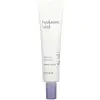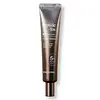What's inside
What's inside
 Key Ingredients
Key Ingredients

 Benefits
Benefits

 Concerns
Concerns

 Ingredients Side-by-side
Ingredients Side-by-side

Water
Skin ConditioningGlycerin
HumectantButylene Glycol
HumectantCoptis Japonica Root Extract
Skin ConditioningCyclopentasiloxane
EmollientDimethicone
EmollientPEG/PPG-18/4 Copolymer
SolventPEG-32
HumectantPortulaca Oleracea Extract
Skin ConditioningTriethanolamine
BufferingCarbomer
Emulsion StabilisingMalpighia Emarginata Fruit Extract
Skin ConditioningPEG-11 Methyl Ether Dimethicone
EmulsifyingPEG-40 Hydrogenated Castor Oil
EmulsifyingPPG-26-Buteth-26
Skin ConditioningVaccinium Angustifolium Fruit Extract
Skin ProtectingEthyl Hexanediol
SolventPolyacrylate-13
Polyisobutene
Glyceryl Caprylate
EmollientAcrylates/C10-30 Alkyl Acrylate Crosspolymer
Emulsion StabilisingPorphyra Yezoensis Extract
Skin ConditioningXanthan Gum
EmulsifyingParfum
MaskingPolysorbate 20
EmulsifyingSodium Hyaluronate
HumectantDisodium EDTA
Linalool
PerfumingButylphenyl Methylpropional
PerfumingHibiscus Sabdariffa Flower Extract
Skin ConditioningWater, Glycerin, Butylene Glycol, Coptis Japonica Root Extract, Cyclopentasiloxane, Dimethicone, PEG/PPG-18/4 Copolymer, PEG-32, Portulaca Oleracea Extract, Triethanolamine, Carbomer, Malpighia Emarginata Fruit Extract, PEG-11 Methyl Ether Dimethicone, PEG-40 Hydrogenated Castor Oil, PPG-26-Buteth-26, Vaccinium Angustifolium Fruit Extract, Ethyl Hexanediol, Polyacrylate-13, Polyisobutene, Glyceryl Caprylate, Acrylates/C10-30 Alkyl Acrylate Crosspolymer, Porphyra Yezoensis Extract, Xanthan Gum, Parfum, Polysorbate 20, Sodium Hyaluronate, Disodium EDTA, Linalool, Butylphenyl Methylpropional, Hibiscus Sabdariffa Flower Extract
Water
Skin ConditioningButylene Glycol
HumectantCaprylic/Capric Triglyceride
MaskingGlycerin
HumectantCetyl Alcohol
EmollientPolyglyceryl-3 Methylglucose Distearate
EmulsifyingPalmitic Acid
EmollientStearic Acid
CleansingUrea
BufferingCyclopentasiloxane
EmollientStearyl Alcohol
EmollientC12-15 Alkyl Benzoate
AntimicrobialGlyceryl Stearate
EmollientCarbomer
Emulsion StabilisingTriethanolamine
BufferingMyristyl Alcohol
EmollientDimethicone
EmollientBetaine
HumectantPropanediol
SolventLimnanthes Alba Seed Oil
Skin ConditioningMacadamia Ternifolia Seed Oil
EmollientLauryl Alcohol
EmollientEthylhexylglycerin
Skin ConditioningPanthenol
Skin ConditioningPvp
Emulsion StabilisingAdenosine
Skin ConditioningDisodium EDTA
Arachidic Acid
CleansingSodium Hyaluronate
HumectantAloe Barbadensis Leaf Juice
Skin ConditioningScutellaria Baicalensis Root Extract
AstringentLauric Acid
CleansingMyristic Acid
CleansingOleic Acid
EmollientRosmarinus Officinalis Leaf Extract
AntimicrobialAloe Barbadensis Leaf Extract
EmollientCamellia Sinensis Leaf Extract
AntimicrobialLavandula Angustifolia Extract
Skin ConditioningBioflavonoids
Skin ConditioningCitric Acid
BufferingBrassica Oleracea Italica Extract
AstringentPalmitoyl Tetrapeptide-7
Skin ConditioningAcetyl Hexapeptide-8
HumectantHydrolyzed Collagen
EmollientPalmitoyl Tripeptide-1
Skin ConditioningSh-Oligopeptide-1
Skin ConditioningSh-Oligopeptide-2
Skin ConditioningSh-Polypeptide-1
Skin ConditioningSh-Polypeptide-16
Skin ProtectingSh-Polypeptide-3
Skin ConditioningHydroxyacetophenone
Antioxidant1,2-Hexanediol
Skin ConditioningCaprylyl Glycol
EmollientSodium Benzoate
MaskingPotassium Sorbate
PreservativePhenoxyethanol
PreservativeWater, Butylene Glycol, Caprylic/Capric Triglyceride, Glycerin, Cetyl Alcohol, Polyglyceryl-3 Methylglucose Distearate, Palmitic Acid, Stearic Acid, Urea, Cyclopentasiloxane, Stearyl Alcohol, C12-15 Alkyl Benzoate, Glyceryl Stearate, Carbomer, Triethanolamine, Myristyl Alcohol, Dimethicone, Betaine, Propanediol, Limnanthes Alba Seed Oil, Macadamia Ternifolia Seed Oil, Lauryl Alcohol, Ethylhexylglycerin, Panthenol, Pvp, Adenosine, Disodium EDTA, Arachidic Acid, Sodium Hyaluronate, Aloe Barbadensis Leaf Juice, Scutellaria Baicalensis Root Extract, Lauric Acid, Myristic Acid, Oleic Acid, Rosmarinus Officinalis Leaf Extract, Aloe Barbadensis Leaf Extract, Camellia Sinensis Leaf Extract, Lavandula Angustifolia Extract, Bioflavonoids, Citric Acid, Brassica Oleracea Italica Extract, Palmitoyl Tetrapeptide-7, Acetyl Hexapeptide-8, Hydrolyzed Collagen, Palmitoyl Tripeptide-1, Sh-Oligopeptide-1, Sh-Oligopeptide-2, Sh-Polypeptide-1, Sh-Polypeptide-16, Sh-Polypeptide-3, Hydroxyacetophenone, 1,2-Hexanediol, Caprylyl Glycol, Sodium Benzoate, Potassium Sorbate, Phenoxyethanol
Ingredients Explained
These ingredients are found in both products.
Ingredients higher up in an ingredient list are typically present in a larger amount.
Butylene Glycol (or BG) is used within cosmetic products for a few different reasons:
Overall, Butylene Glycol is a safe and well-rounded ingredient that works well with other ingredients.
Though this ingredient works well with most skin types, some people with sensitive skin may experience a reaction such as allergic rashes, closed comedones, or itchiness.
Learn more about Butylene GlycolCarbomer is a polymer of acrylic acid. Its main role is to create a gel consistency.
A high amount of carbomer can cause pilling or balling up of products. Don't worry, most products contain 1% or less of carbomer.
Cyclopentasiloxane, or D5, is a silicone used to improve texture of products and trap moisture.
D5 is considered lightweight and volatile. Volatile means it evaporates quickly after application. Once evaporated, D5 leaves a thin barrier that helps keep skin hydrated.
It is also an emollient. Emollients help soften the skin and prevent water loss. Silicones create a silky texture in products. D5 helps other ingredients become more spreadable.
Studies show D5 is safe to use in skincare products. We recommend speaking with a skincare professional if you have concerns.
Learn more about CyclopentasiloxaneDimethicone is a type of synthetic silicone created from natural materials such as quartz.
What it does:
Dimethicone comes in different viscosities:
Depending on the viscosity, dimethicone has different properties.
Ingredients lists don't always show which type is used, so we recommend reaching out to the brand if you have questions about the viscosity.
This ingredient is unlikely to cause irritation because it does not get absorbed into skin. However, people with silicone allergies should be careful about using this ingredient.
Note: Dimethicone may contribute to pilling. This is because it is not oil or water soluble, so pilling may occur when layered with products. When mixed with heavy oils in a formula, the outcome is also quite greasy.
Learn more about DimethiconeDisodium EDTA plays a role in making products more stable by aiding other preservatives.
It is a chelating agent, meaning it neutralizes metal ions that may be found in a product.
Disodium EDTA is a salt of edetic acid and is found to be safe in cosmetic ingredients.
Learn more about Disodium EDTAGlycerin is already naturally found in your skin. It helps moisturize and protect your skin.
A study from 2016 found glycerin to be more effective as a humectant than AHAs and hyaluronic acid.
As a humectant, it helps the skin stay hydrated by pulling moisture to your skin. The low molecular weight of glycerin allows it to pull moisture into the deeper layers of your skin.
Hydrated skin improves your skin barrier; Your skin barrier helps protect against irritants and bacteria.
Glycerin has also been found to have antimicrobial and antiviral properties. Due to these properties, glycerin is often used in wound and burn treatments.
In cosmetics, glycerin is usually derived from plants such as soybean or palm. However, it can also be sourced from animals, such as tallow or animal fat.
This ingredient is organic, colorless, odorless, and non-toxic.
Glycerin is the name for this ingredient in American English. British English uses Glycerol/Glycerine.
Learn more about GlycerinSodium Hyaluronate is hyaluronic acid's salt form. It is commonly derived from the sodium salt of hyaluronic acid.
Like hyaluronic acid, it is great at holding water and acts as a humectant. This makes it a great skin hydrating ingredient.
Sodium Hyaluronate is naturally occurring in our bodies and is mostly found in eye fluid and joints.
These are some other common types of Hyaluronic Acid:
Learn more about Sodium HyaluronateTriethanolamine is an emulsifier and pH adjuster. It is created using ethylene oxide and ammonia. This gives Triethanolamine a nitrogen core and a similar scent to ammonia.
As an emulsifier, it prevents ingredients from separating and enhances texture by adding volume to a product.
PH adjusters are common in cosmetic products. The pH of a product can affect the effectiveness of other ingredients. A product with a high pH may also irritate the skin.
Learn more about TriethanolamineWater. It's the most common cosmetic ingredient of all. You'll usually see it at the top of ingredient lists, meaning that it makes up the largest part of the product.
So why is it so popular? Water most often acts as a solvent - this means that it helps dissolve other ingredients into the formulation.
You'll also recognize water as that liquid we all need to stay alive. If you see this, drink a glass of water. Stay hydrated!
Learn more about Water